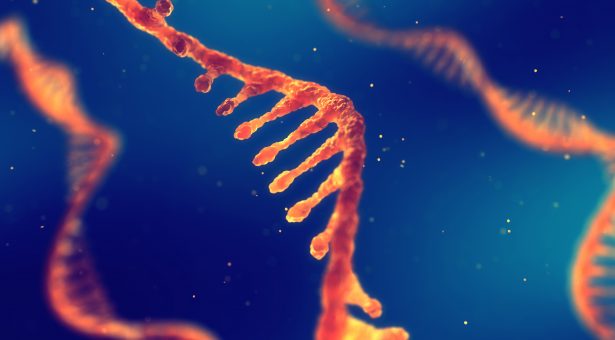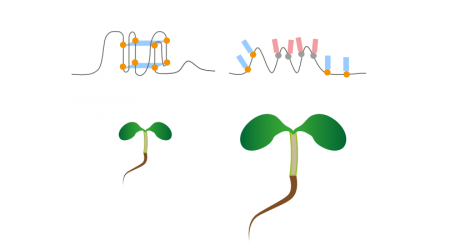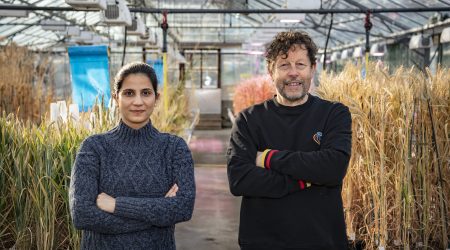What is RNA?

Dr Yiliang Ding and her group at the John Innes Centre have been awarded prestigious European funding to take forward pioneering research into RNA and its structure. Find out more about this flexible molecule and its role in plant, animal and human health.
RNA stands for RiboNucleic Acid and is an important molecule throughout all organisms, including single-celled microorganisms, plants and humans.
While most people have heard of DNA, RNA is less well-known despite being equally crucial to life on earth. It has even been suggested RNA was the first form of life on our planet.
RNA is involved in many cellular processes and has potential in wide range of applications across plant, animal and human health. RNA is like DNA in that it is a nucleic acid, a large biomolecule composed of carbon, phosphate and nitrogen. Also, just like DNA, it consists of bases containing nitrogen atoms that encode and carry information. In RNA these nitrogenous bases are adenine, cytosine, uracil and guanine.
What does RNA look like?
Often RNA has been depicted as single-stranded in comparison to the familiar double-stranded structure of DNA, but recent research is discovering that the shape of RNA is more complex.
RNA can form double strands, for example giving hairpin-like structures and forming what is known as a secondary structure. Zooming further out, RNA can fold further into an overall three-dimensional structure – called its tertiary structure.
One example of tertiary structure is RNA G-quadruplex structures (rG4). Four guanine bases (G) on the RNA can interact with each to form a G-quartet and multi-layered G-quartets can form stable rG4 , making them an essential component in various biological processes. Previously they had only been observed in lab conditions, but have now been found in nature too.
Researchers here at the John Innes Centre are at the forefront of understanding the shapes of RNA in plants. The Ding group for example, have pioneered RNA structure research, developing several chemical probing-based technologies, which allows the structures of RNA to be captured in living plant cells. As Dr Yiliang describes, it has revealed “RNA is not a skinny molecule but has a toned structure”.
What does RNA do?
The ubiquitous biomolecule has diverse and important roles inside cells, and there are several types of RNA that have different roles in biology. RNA is essential to the production of proteins and is involved in many steps of this process. Here are the main types of RNA involved in this process.
- Messenger RNA
DNA is found inside the nucleus, the information hub of the cell. The DNA is transcribed into what is called messenger RNA (mRNA). In this process, only the parts of the DNA that encode the proteins (not the regulatory parts of DNA) are transcribed into the mRNA. The messenger RNA then carries the information outside of the nucleus, to other parts of the cell, where the protein will be made.
- Transfer RNA
Another type of RNA is important for the next step of protein production. Transfer RNA (tRNA) acts as building blocks. It matches up to the messenger RNA template, bringing with it specific amino acids. The amino acids then bond together to produce the protein.
- Ribosomal RNA
The process of tRNA matching up with mRNA happens inside a macromolecular machine called a Ribosome. Ribosomes can be thought of as the protein factories of cells. The ribosome itself is also partly constructed from RNA, called ribosomal RNA (rRNA).
Recent research is also uncovering how RNA has a role beyond being a machine and template for protein production, and is important in regulation whether it be at the DNA level through epigenetics or later once mRNA has been transcribed. For example researchers here at the John Innes Centre in the Dean group have discovered a physical link between RNA processing and the regulation of DNA. Here are some types of RNA involved in gene regulation:
- siRNA
RNAs are also able to block biological messages, as well as carry them. In plants, this was first discovered here in Norwich at our sister laboratory the Sainsbury Lab, by Sir David Baulcombe who discovered that plants produce RNAs to protect against viruses. These RNA’s are called small interfering RNAs (siRNAs) and are double-stranded RNAs about 20-27 base pairs in length. SiRNAs are specific in their ability to intercept and destroy messenger RNA
- microRNA
A similar type of RNA is microRNA (miRNA), which also blocks messages though in a less specific way, and is able to stop several messenger RNAs at once. MiRNAs are involved in regulating gene expression across organisms, though the molecular machinery that allows miRNAs to break down messenger RNA is slightly different between plants and animals. Here at the John Innes Centre, the Ding group has discovered how the shape of RNA in nature is important in determining which messenger RNA is broken down by a miRNA. The group have figured out how to predict which messenger RNAs are intercepted and broken down by miRNA.
The important, diverse and specific roles of RNA offer opportunities across plant, animal human health.
For example, some of the vaccines against Covid-19 currently are messenger RNA that encode for the outer spike proteins of the coronavirus.
In terms of plant health, siRNAs could be used to inhibit plant viruses providing an environmentally-friendly alternative to chemical pesticides.
There’s still much more to learn about RNA. It’s increasingly clear that it’s not just the simple linear molecule that acts as a stepping between DNA and proteins, but exists in many complex structures that gives RNA diverse and nuanced roles in biology.
Learning more about RNA works can help us develop innovative solutions to achieve healthy plants, healthy people and a healthy planet.



